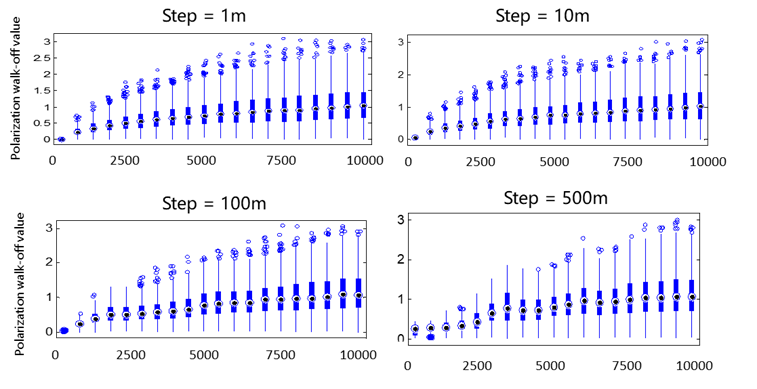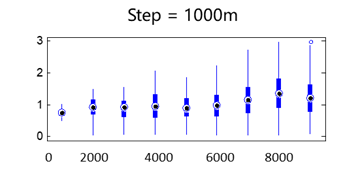Dear colleagues,
Regarding our presentation on May 24th meeting, Mr. John Johnson has brought up a question on our choice of 1m as the step length when simulating the polarization walk-off of two signals propagating along a
SMF.
We have further applied the model using different step lengths, their results listed below. We find that the behavior of polarization walk-off value changing with fiber length is consistent in all five cases of step length.
For very coarse step length, the polarization walk-off value exhibits a periodic fluctuation on top of its growing trend. This behavior
matches the comment in a 2021 journal article[1]:
“The number of birefringence
segments N is an important factor we should consider. A large N would be better for emulating PMD characteristics and N → ∞ is ideally optimal. However, in practice, the cost will limit the permissible number. In fact, the small N will cause the undesired
periodic behaviors of DGD, the components of PMD vector, or the frequency ACF.”
We used the waveplate model (or Hinge Model) to analyze temporal and spectral evolution of PMD. The variation of PMD can be caused by all kinds of external perturbation. Since we are considering the statistical distribution
of PMD over long time, the correlation length (lc) was not been taken into account at the time.
We appreciate Mr. Johnson’s comment. We will use step lengths of both 1m and 100m in our future simulation analysis on the link model.


[1] Cui N, Zhang X, Zhang Q, et al. Narrow-or wide-band channel for a high baud rate fiber communication system: a judgment based
on a temporal and spectral evolution PMD model[J]. Optics Express, 2021, 29(23): 38497-38511.
Appendix: A quick recap on the Hinge model:
fiber link is modeled as a concatenation of many birefringence elements with random orientation and DGD. Both birefringence strength and orientation vary randomly on
each segment.

![]()
DGD of each segment:
![]()
Through a large number of random seeds, pdf of the DGD should be Maxwellian distributed.
The rotation angles θi and ϕi are uniformly distributed random variables in the range of [0, 2π].
To unsubscribe from the STDS-802-3-B400G-OPTX list, click the following link: https://listserv.ieee.org/cgi-bin/wa?SUBED1=STDS-802-3-B400G-OPTX&A=1